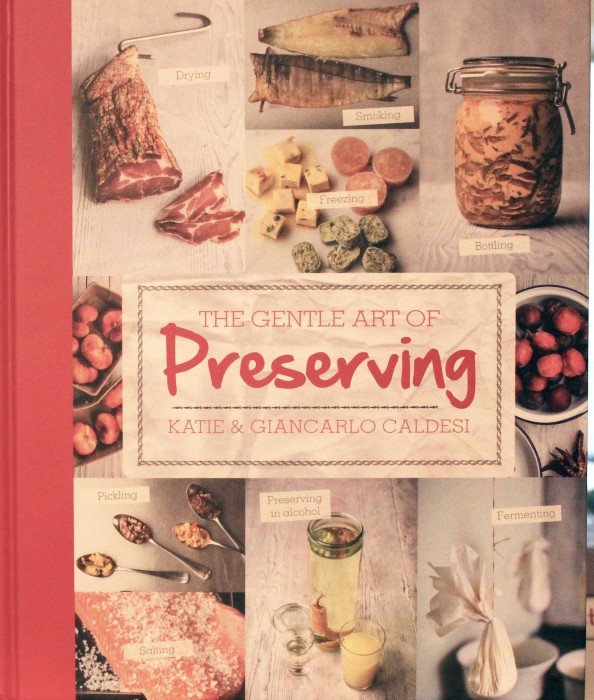It seems impossible that this TBT cookbook appeared five years ago. Suzi and I turn to books by the Caldesis almost every day. This book on preserving is in a class by itself, an encyclopedia of all the preserving techniques that mankind has fashioned. It will officially be summer next week and the time when we have the broadest array of food items to enjoy. And to ponder. This book will give you new ideas to deal with those berries and fruits and veggies. Ideas that will let you enjoy their flavors when the leaves have fallen. And the snow has, too!
What do you have in your kitchen that you should thank Napoleon Bonaparte for? It’s not something. It’s somethings. Lots of somethings. Right there on your shelves.
Cans and jars. In 1809 a French confectioner and brewer, Nicolas Appert, discovered that if he sealed food in a glass container and then heated the container, the food inside was edible for many months. Appert was credited with “making the seasons stand still” and won a 12,000-franc prize offered by Napoleon. Napoleon needed a way to preserve food so his armies could march across Europe and not be dependent on local foraging.
While he got his cans, Napoleon did not have enough of them during a certain Moscow winter. While Napoleon ultimately lost, today we are all winners: canned and jarred foods are in almost every household. It is difficult to imagine life without them. Why, we’d be living as if it were 1808!
The use of heat is just one of several basic preservation techniques to preserve food. The Gentle Art of Preserving, by Katie and Giancarlo Caldesi, is a detailed, readable education about all the ways mankind has discovered to save today’s bites for tomorrow [or a few months or years down the road]. Chapters are devoted to:
• Vinegar
• Sugar
• Salt
• Air
• Smoke
• Oil, Fat & Butter
• Alcohol
• Fermenting
• Heat
• Cold
Author Katie Caldesi is a food professional, an author and owner of the only Italian cooking school in London. Husband Giancarlo is a restaurateur and expert on the Italian arts of preserving meats [that Air chapter is his]. Food is their passion and livelihood.
Authors sometimes start down one path, and then find themselves on another. In the forward to this book, the Caldesis say they did not intend to create the bible for food preservation. Rather, they just wanted a personal, celebratory book with simple techniques that we can all follow.
They have succeeded in doing both. First and foremost, this book really is a bible, if not the bible, for food preservation. If you were a senior in college, polishing off a major in culinary science, then this would be the book for your food preservation course. This is not a science book with lots of equations or chemical diagrams. But Gentle Art is packed with facts and numbers to guide you into the details of preservation.
The book begins with villains: what are the reasons we need to preserve food? The usual suspects are described: enzymes, molds, yeasts, and bacteria. Then each of those chapters above follows a careful format:
- • When did the technique begin
- • Which of the villains does it deal with
- • More importantly, which villains doesn’t it work with [which is why you need salt along with smoke]
- • Details on how to apply the technique
- • Wonderful recipes
Every page of this book has explanations for what you do and why you do it. So, you won’t be skimming this tome. This book is not just about making pickles or jam. It’s about the reasons for and best practices to apply when using each of the preservation techniques.
For example, the smoking chapter covers:
- • Exactly how smoking preserves food
- • Hot and cold smoking
- • Wood choices for smoking
- • How to smoke on cold days or when the humidity is low
- • Smoking devices: cold versus hot
- • How long to smoke for
- • Brining and salting as preparation
- And then there are the recipes. In the smoking chapter alone, you’ll find recipes for:
- • Cold smoked cheese
- • Cold and hot smoked salmon
- • Cold smoked shrimp and trout
- • Boston butt barbecue
- • Hot smoked pheasant
This smoking chapter includes, appropriately, rubs and sauces to expand the smoky flavors.
If you have a yen for tanginess and the power of some culinary chemistry, then the chapter on fermentation will have you making:
- • Yogurt
- • Crème fraiche
- • Sourdough bread
- • Kimchi
- • Raspberry wine
- • Sparkling elderflower wine
- • Apple cider
That underlying goal of the Caldesis, to make this an inviting book for families to share, is achieved on every page and with every recipe. Their intent was to open your eyes to what preservation techniques can achieve and to understand why. Those goals are achieved, even surpassed. Although I think when you try the Sweet Chile Jam, your mind is going to focus that moment on the zip of that chili-vinegar-ginger-tomato-sugar combination and not on the chemistry of malt vinegar.
Sometimes you just have to take a bit of a break off the busy highway of life. Sit back and wonder how it is that we do what we do. If you are a foodie, you’ll want to pause, read, learn, and have another bite of that sweet chili jam. On the sourdough bread you made.

